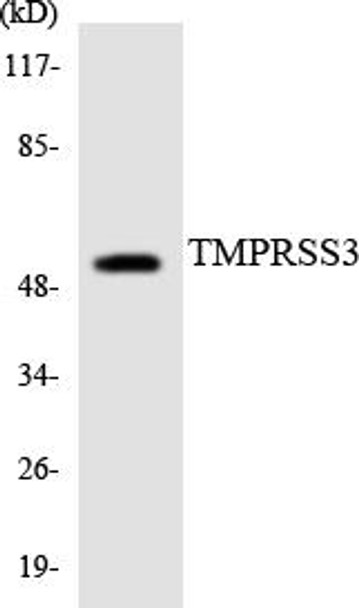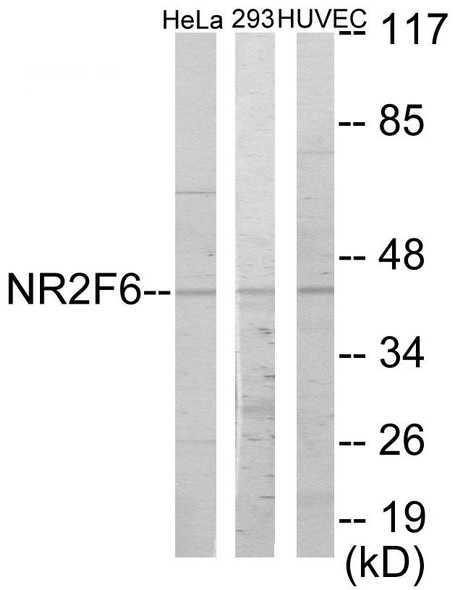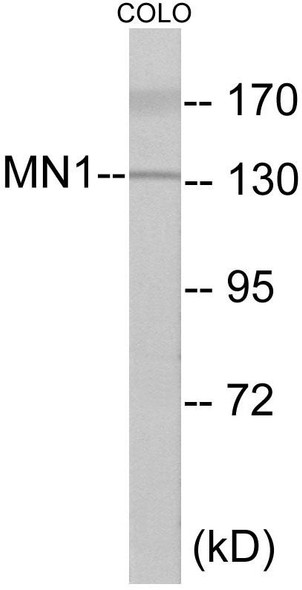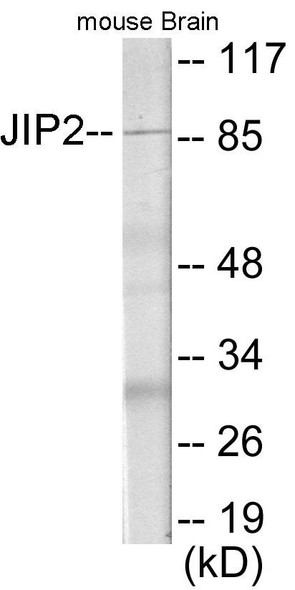Description
TMPRSS3 Colorimetric Cell-Based ELISA
The TMPRSS3 Colorimetric Cell-Based ELISA Kit is a cutting-edge tool for researchers seeking to detect and quantify levels of TMPRSS3 in cell culture supernatants. This kit offers unparalleled sensitivity and specificity, ensuring accurate and reproducible results for a wide range of applications.TMPRSS3 is a vital enzyme involved in various cellular processes, including cell growth and differentiation.
Dysregulation of TMPRSS3 has been linked to diseases such as cancer and inflammatory disorders, making it a valuable biomarker for research and potential therapeutic development.With the TMPRSS3 Colorimetric Cell-Based ELISA Kit, researchers can gain valuable insights into the role of TMPRSS3 in health and disease, paving the way for new discoveries and treatment opportunities.
| Product Name: | TMPRSS3 Colorimetric Cell-Based ELISA |
| Product Code: | CBCAB01046 |
| ELISA Type: | Cell-Based |
| Target: | TMPRSS3 |
| Reactivity: | Human, Mouse |
| Dynamic Range: | > 5000 Cells |
| Detection Method: | Colorimetric 450 nmStorage/Stability:4°C/6 Months |
| Format: | 96-Well Microplate |
The TMPRSS3 Colorimetric Cell-Based ELISA Kit is a convenient, lysate-free, high throughput and sensitive assay kit that can detect TMPRSS3 protein expression profile in cells. The kit can be used for measuring the relative amounts of TMPRSS3 in cultured cells as well as screening for the effects that various treatments, inhibitors (ie siRNA or chemicals), or activators have on TMPRSS3.
Qualitative determination of TMPRSS3 concentration is achieved by an indirect ELISA format. In essence, TMPRSS3 is captured by TMPRSS3-specific primary antibodies while the HRP-conjugated secondary antibodies bind the Fc region of the primary antibody. Through this binding, the HRP enzyme conjugated to the secondary antibody can catalyze a colorimetric reaction upon substrate addition. Due to the qualitative nature of the Cell-Based ELISA, multiple normalization methods are needed:
| 1. | A monoclonal antibody specific for human GAPDH is included to serve as an internal positive control in normalizing the target absorbance values. |
| 2. | Following the colorimetric measurement of HRP activity via substrate addition, the Crystal Violet whole-cell staining method may be used to determine cell density. After staining, the results can be analysed by normalizing the absorbance values to cell amounts, by which the plating difference can be adjusted. |
| Database Information: | Gene ID: 64699, UniProt ID: P57727, OMIM: 601072/605316/605511, Unigene: Hs.208600 |
| Gene Symbol: | TMPRSS3 |
| Sub Type: | None |
| UniProt Protein Function: | TMPRSS3: Probable serine protease that play a role in hearing. Acts as a permissive factor for cochlear hair cells survival and activation at the onset of hearing and is required for saccular hair cell survival. Activates ENaC (in vitro). Defects in TMPRSS3 are the cause of deafness autosomal recessive type 8 (DFNB8). DFNA8 is a form of sensorineural hearing loss. Sensorineural deafness results from damage to the neural receptors of the inner ear, the nerve pathways to the brain, or the area of the brain that receives sound information. Defects in TMPRSS3 are the cause of deafness autosomal recessive type 10 (DFNB10). Belongs to the peptidase S1 family. 5 isoforms of the human protein are produced by alternative splicing. |
| UniProt Protein Details: | Protein type:Protease; Membrane protein, integral; Endoplasmic reticulum; EC 3.4.21.- Chromosomal Location of Human Ortholog: 21q22.3 Cellular Component: endoplasmic reticulum; endoplasmic reticulum membrane Molecular Function:sodium channel regulator activity Biological Process: cellular sodium ion homeostasis Disease: Deafness, Autosomal Recessive 8 |
| NCBI Summary: | This gene encodes a protein that belongs to the serine protease family. The encoded protein contains a serine protease domain, a transmembrane domain, an LDL receptor-like domain, and a scavenger receptor cysteine-rich domain. Serine proteases are known to be involved in a variety of biological processes, whose malfunction often leads to human diseases and disorders. This gene was identified by its association with both congenital and childhood onset autosomal recessive deafness. This gene is expressed in fetal cochlea and many other tissues, and is thought to be involved in the development and maintenance of the inner ear or the contents of the perilymph and endolymph. This gene was also identified as a tumor-associated gene that is overexpressed in ovarian tumors. Alternatively spliced transcript variants have been described. [provided by RefSeq, Jan 2012] |
| UniProt Code: | P57727 |
| NCBI GenInfo Identifier: | 13124582 |
| NCBI Gene ID: | 64699 |
| NCBI Accession: | P57727.2 |
| UniProt Secondary Accession: | P57727,Q5USC7, Q6ZMC3, D3DSJ6, |
| UniProt Related Accession: | P57727 |
| Molecular Weight: | 58,324 Da |
| NCBI Full Name: | Transmembrane protease serine 3 |
| NCBI Synonym Full Names: | transmembrane protease, serine 3 |
| NCBI Official Symbol: | TMPRSS3 |
| NCBI Official Synonym Symbols: | DFNB8; DFNB10; ECHOS1; TADG12 |
| NCBI Protein Information: | transmembrane protease serine 3 |
| UniProt Protein Name: | Transmembrane protease serine 3 |
| UniProt Synonym Protein Names: | Serine protease TADG-12; Tumor-associated differentially-expressed gene 12 protein |
| Protein Family: | Transmembrane protease serine |
| UniProt Gene Name: | TMPRSS3 |
| UniProt Entry Name: | TMPS3_HUMAN |
| Component | Quantity |
| 96-Well Cell Culture Clear-Bottom Microplate | 2 plates |
| 10X TBS | 24 mL |
| Quenching Buffer | 24 mL |
| Blocking Buffer | 50 mL |
| 15X Wash Buffer | 50 mL |
| Primary Antibody Diluent | 12 mL |
| 100x Anti-Phospho Target Antibody | 60 µL |
| 100x Anti-Target Antibody | 60 µL |
| Anti-GAPDH Antibody | 60 µL |
| HRP-Conjugated Anti-Rabbit IgG Antibody | 12 mL |
| HRP-Conjugated Anti-Mouse IgG Antibody | 12 mL |
| SDS Solution | 12 mL |
| Stop Solution | 24 mL |
| Ready-to-Use Substrate | 12 mL |
| Crystal Violet Solution | 12 mL |
| Adhesive Plate Seals | 2 seals |
The following materials and/or equipment are NOT provided in this kit but are necessary to successfully conduct the experiment:
- Microplate reader able to measure absorbance at 450 nm and/or 595 nm for Crystal Violet Cell Staining (Optional)
- Micropipettes with capability of measuring volumes ranging from 1 µL to 1 ml
- 37% formaldehyde (Sigma Cat# F-8775) or formaldehyde from other sources
- Squirt bottle, manifold dispenser, multichannel pipette reservoir or automated microplate washer
- Graph paper or computer software capable of generating or displaying logarithmic functions
- Absorbent papers or vacuum aspirator
- Test tubes or microfuge tubes capable of storing ≥1 ml
- Poly-L-Lysine (Sigma Cat# P4832 for suspension cells)
- Orbital shaker (optional)
- Deionized or sterile water
*Note: Protocols are specific to each batch/lot. For the correct instructions please follow the protocol included in your kit.
| Step | Procedure |
| 1. | Seed 200 µL of 20,000 adherent cells in culture medium in each well of a 96-well plate. The plates included in the kit are sterile and treated for cell culture. For suspension cells and loosely attached cells, coat the plates with 100 µL of 10 µg/ml Poly-L-Lysine (not included) to each well of a 96-well plate for 30 minutes at 37°C prior to adding cells. |
| 2. | Incubate the cells for overnight at 37°C, 5% CO2. |
| 3. | Treat the cells as desired. |
| 4. | Remove the cell culture medium and rinse with 200 µL of 1x TBS, twice. |
| 5. | Fix the cells by incubating with 100 µL of Fixing Solution for 20 minutes at room temperature. The 4% formaldehyde is used for adherent cells and 8% formaldehyde is used for suspension cells and loosely attached cells. |
| 6. | Remove the Fixing Solution and wash the plate 3 times with 200 µL 1x Wash Buffer for five minutes each time with gentle shaking on the orbital shaker. The plate can be stored at 4°C for a week. |
| 7. | Add 100 µL of Quenching Buffer and incubate for 20 minutes at room temperature. |
| 8. | Wash the plate 3 times with 1x Wash Buffer for 5 minutes each time. |
| 9. | Add 200 µL of Blocking Buffer and incubate for 1 hour at room temperature. |
| 10. | Wash 3 times with 200 µL of 1x Wash Buffer for 5 minutes each time. |
| 11. | Add 50 µL of 1x primary antibodies (Anti-TMPRSS3 Antibody and/or Anti-GAPDH Antibody) to the corresponding wells, cover with Parafilm and incubate for 16 hours (overnight) at 4°C. If the target expression is known to be high, incubate for 2 hours at room temperature. |
| 12. | Wash 3 times with 200 µL of 1x Wash Buffer for 5 minutes each time. |
| 13. | Add 50 µL of 1x secondary antibodies (HRP-Conjugated AntiRabbit IgG Antibody or HRP-Conjugated Anti-Mouse IgG Antibody) to corresponding wells and incubate for 1.5 hours at room temperature. |
| 14. | Wash 3 times with 200 µL of 1x Wash Buffer for 5 minutes each time. |
| 15. | Add 50 µL of Ready-to-Use Substrate to each well and incubate for 30 minutes at room temperature in the dark. |
| 16. | Add 50 µL of Stop Solution to each well and read OD at 450 nm immediately using the microplate reader. |
(Additional Crystal Violet staining may be performed if desired – details of this may be found in the kit technical manual.)






